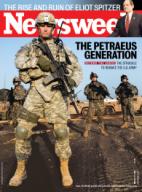
24 March issue of Newsweek - Five years on, the war is transforming the American officer corps...
Scions of the Surge by Babak Dehghanpisheh and Evan Thomas
... Many Americans were asking that question last spring and summer. While it's too soon to say Iraq has turned the corner, the violence in Baghdad and most of the country has since declined precipitously. Much of the credit has gone to Gen. David Petraeus, the commander who has changed the way the U.S. Army fights. "You can't kill your way out of an insurgency," Petraeus told Newsweek, in an interview in his Baghdad headquarters last month. He has moved soldiers out of their secure megabases and into small outposts deep inside once alien and hostile neighborhoods, and he has ordered his men out of their armored convoys. "Walk ... Stop by, don't drive by," says Petraeus, reading from a "guidance" he is drafting for his soldiers. The objective, he repeats over and over, is no longer to take a hill or storm a citadel, but to win over the people.
But this new way of war needs a new kind of warrior, and it needs tens of thousands of them. Five years into the longest conflict the U.S. military has fought since Vietnam, young officers like Tim Wright have been blooded by multiple tours in Iraq and Afghanistan. They've learned, often on their own, operating with unprecedented independence, the intricacies of Muslim cultures. Faced with ineffective central governments, they have acted as mayors, mediators, cops, civil engineers, usually in appalling surroundings. Most recently, and hardest of all, they've had to reach out and ally themselves with men who have tried and often succeeded in killing their own soldiers. Brought up in rigid, flag-waving warrior cultures that taught right from wrong, black from white, they've had to learn to operate amid moral ambiguity, to acknowledge the legitimate aspirations of their enemies...
The Fight Over How to Fight by Evan Thomas and John Barry
... But what if a military must prepare to fight not one war, but two very different kinds of war? That is the challenge facing the world's greatest superpower at the beginning of the 21st century. The American military must continue to ready itself for high-tech warfare; it must still be able to fight "big wars" against rising powers like China. At the same time, it must anticipate what military planners blandly term "low-intensity conflict" but what Rudyard Kipling more aptly called the "savage wars of peace"—small, asymmetrical conflicts against determined partisans with wicked low-tech weapons like IEDs, the improvised explosive devices that have cost America so dearly in Iraq.
The tension over which war to prepare for has created a generational divide in the American military, particularly the U.S. Army, between old bulls who want to focus on all-out combat, drowning the enemy in precision firepower, and young upstarts who believe that in today's messy world of failing states, firepower is not enough—it is necessary to win hearts and minds...
The Enemy Comes in From the Cold by Larry Kaplow
Hawija is a mean town, decaying and sullen. Not long ago a sniper hit a soldier from Black Sheep Company while he was standing inside a downtown police station. But the company's commander, 32-year-old Capt. Quinn Eddy of the 87th Infantry Regiment, 10th Mountain Division, speaks without malice of the insurgents taking potshots at his men. "A lot are just triggers who get paid," he says. "They're just trying to survive." Before Iraq, Eddy served a tour in Afghanistan. The enemy in Hawija, he says, is "not the same Al Qaeda that you and I know."...
'A Good Way to Spread a Message' by Babak Dehghanpisheh
... Greater cultural sensitivity has long been a goal of the U.S. Army in Iraq, but only lately, as soldiers come back for the second or third time and deploy deeper into Baghdad neighborhoods, has it become a reality. It's paid off. Late last summer, Marckwardt bonded with a soft-spoken university professor named Abu Muthana over their shared love of Spanish. Disillusioned with the insurgency, Abu Muthana now commands a U.S.-supported neighborhood patrol group. "We thought the Americans were our enemy," he says. "But we Iraqis woke up and realized we have a common enemy." That's not all they have in common.
'The Fight That We Are in Now' by Larry Kaplow
Capt. Neil Hollenbeck declines to second-guess whether America should have invaded Iraq. What he will say is this: "The reason we invaded Iraq to begin with and the reason we're fighting now are different. We're fighting different enemies now." He pauses to think. "The threat we're fighting now is instability and terrorism." Another pause. "The fight that we are in now is not one of our choosing. It's just one we're choosing not to walk away from." Questions of winning and losing are above his rank, he adds, although he thinks a stable Iraq, with a government that can grow into its responsibilities, is "obtainable."
That's why he's here, hunting down the last Al Qaeda in Iraq fighters in the rural Arab Jabour district, south of Baghdad. Hollenbeck and his troops live in an abandoned farmhouse with no running water or electricity, only a generator to run their radios and a light or two. He doesn't mind roughing it; that's part of the strategy. The main thing is to protect the people: you have to live among them, not on heavily fortified bases, as Gen. David Petraeus's counterinsurgency manual says. When the book first came out, Hollenbeck was at Fort Benning, taking classes in conventional warfare between deployments to Iraq. He remembers how good it felt to read something that actually applied to the unconventional conflict he had seen in Iraq...
Images of War: Photographic timeline of the five years of conflict in Iraq
Video: U.S. Troops in Their Own Words
Video: Inside an Iraq Preschool
